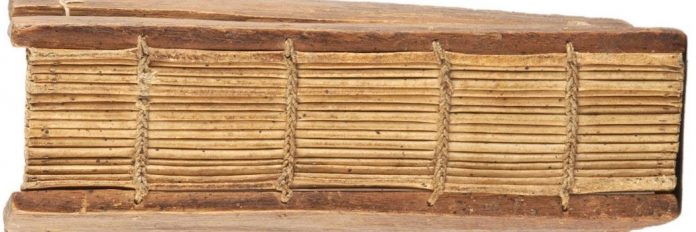
.
Stitching and binding of books.One of the craft trades oldest is the binding of books. Unfortunately, like almost all crafts, it is being lost, being replaced by automated industrial processes that, even giving the same result, have nothing to do with it.
His process has seemed to us the most curious and instructive, for this reason, we have decided to dedicate a series of articles to the book binding.
In this first article, our friends at tricksandcrafts.comthey explain to us what it consists of and how it is carried out the sewing of the book.
The sewing of the sheets is the operation that contributes in a decisive way to the achievement of the objective that we have set ourselves: to bind a book. For this we must have an appropriate loom, ribbon or string, thread, needle and patience.
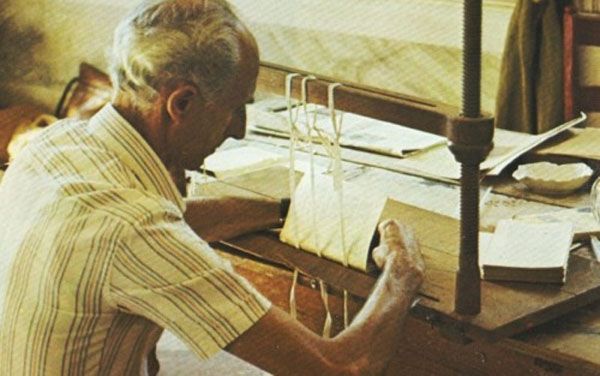
To carry out the operation of sewing what is to form the body of the book, it is necessary, first of all, to make sure that the sheets that make it up are in order, either by consulting the numbers of the signatures, or by checking the numbering of the pages or taking a look at the garlands or stains on the spine of the sheets.
In the case that concerns us, we must also make sure that they have been glued, according to the process explained in another article that we will publish soon, the guards in the first and last sheet.
In the sewing process the main role is played by the loom, which deserves a particular description. It is a board at the ends of which there are two wooden spindles with their corresponding nuts.
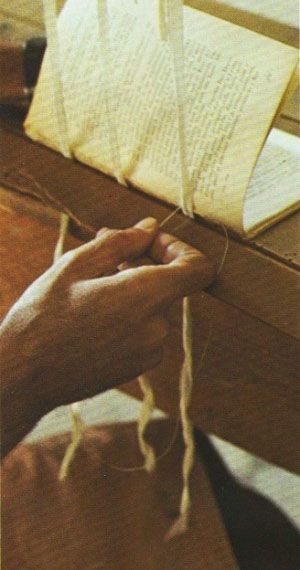
Moment in which the needle, which comes from inside the sheet, is going to penetrate it again after passing to the other side of the tape so that it is held by the thread.
In the aforementioned board, and between the spindles, there is a slot through which the strings or ribbons used for binding pass, which are held at the bottom in a kind of small strip and at the top they are tied to a horizontal crossbar crossed by the spindles and which, when ascending or descending by means of the nuts, gives the necessary tension to the ribbons or cords.
After such review, the book as a whole is placed to the left of the loom and the person who is going to sew them but inverted, that is, so that the last sheet is the first and that the head of the book is also left on the loom bench.
In our case, as can be seen in the initial photo of this article, the book is going to be sewn by three ribbons, which are 60 to 70 cm long and have been fixed to the bottom of the loom. They are then tied to the upper bar of the former and tightened using the nuts.
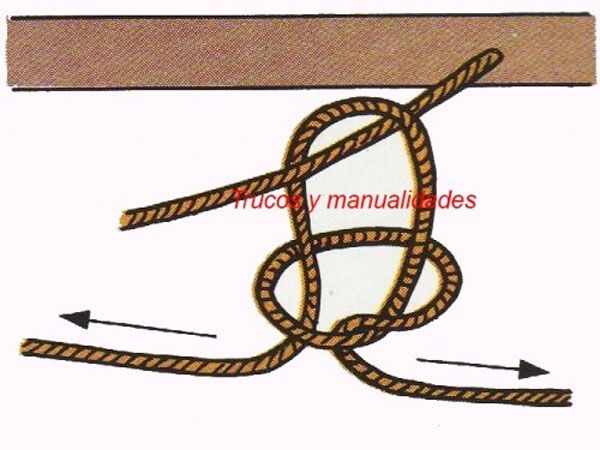
WEAVING KNOT. Used to join one end of the thread that is used and tie it with another to continue the operation.
Before carrying out this operation, it is necessary to measure the distances at which they must be placed and those between them, which are given by the marks that have been made by the previous sawing of the back of the sheets. If strings are used instead of ribbons, the procedure is almost the same.
When it comes to sewing a few sheets, it is customary to thread the needle with a thread whose length is equivalent to the product of the size of the sheets by their number. In any case, it is usually cumbersome to work with threads that are too long, since the thread tangles easily and this causes a considerable loss of time.
In the normal case, it is threaded with a piece of thread of the desired length, that is, the most suitable for working, which will be joined to the following piece or pieces by means of a weaver’s knot. The way to do it is represented in the upper drawing of this same page. The thread that enjoys the greatest prestige among professionals is raw linen.
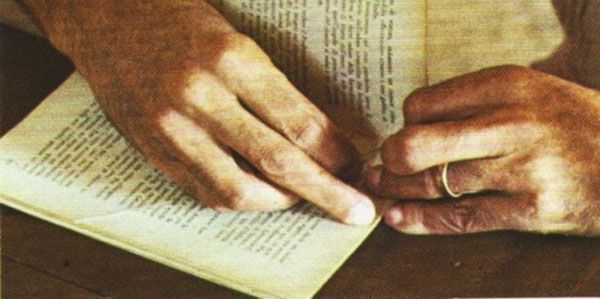
Demonstration of how to sew with the right hand while the left hand holds the sheet open.
In order that there are no lumps that could make the spine ugly, care should be taken that this knot always remains on the inside of the sheet and in the space between two ribbons or cords, depending on the material used.
To start the sewing, the last sheet of the book is supported, which has been placed to the left of the loom in an inverted position, that is, this last sheet is the first within reach of the bookbinder, with the guard placed in the way already explained. on the loom bed.
Next, the sheet is opened in the center with the left hand, which will be left there and maintained throughout the sewing, since in it the right hand holds and makes the needle work, while the left hand keeps the successive sheets open.

The thread hugs the ribbons.
Drawing that shows how the thread should hug the ribbon or string.
The sewing begins on the right, passing the needle through the first hole produced by the saw and from the outside to the inside.
Then it is passed from the inside to the outside through the second mark and continues in this way with the other holes or marks, so that the thread always embraces the tapes that are used on the spine of the sheet.
Upon reaching the last hole or mark, the needle must go from the inside to the outside. Then proceed to stretch the thread well, but leave about 10 cm free of it at the point where the sewing began. This type of sewing is called “continuous stitch”.

PHASES OF THE CHAIN.
The three drawings graphically represent the start of the chain stitch and its result as new sheets are sewn. In the two lower photographs you can see, on the left, the practical way of making the chain stitch and, on the right, the act of cutting the excess tape or cord used in the sewing operation in which you should try to leave always 3 to 4 cm of tape or twine on each side of the book, before continuing with the binding operations.
The next act is to take the second sheet, which is actually the penultimate in the book and is sewn in the same way as before, but from left to right. Once reached the point where the first round began, it is then tied with the thread of the first sheet that was left loose there.
The same is then repeated with the third sheet, but, upon reaching the end, at the last mark or hole, the needle and thread are passed under the point that joins the first and second sheets, which begins the so-called chain, whose sketch appears at the top of this page. This kind of stitching is called .
The chain stitch consists of joining the sheet already sewn with the previous ones by passing the needle between the last two sheets already sewn and pulling the thread until the loop thus formed is hidden in the groove that was previously marked with the saw.
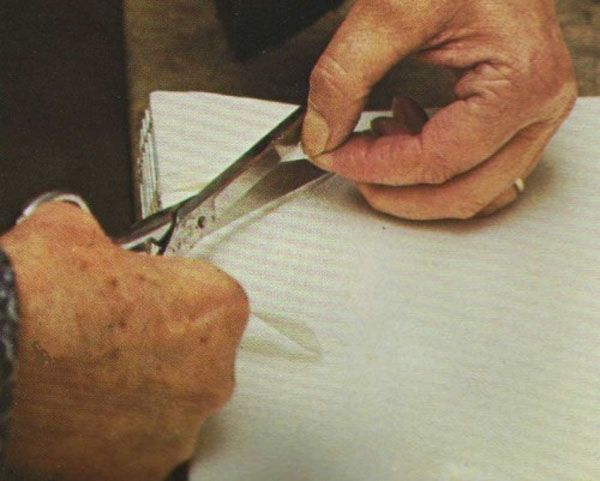
When the book is already sewn, by whatever procedure, it is inserted into the press and left there for a few hours.
The process continues in the same way until all the sheets of the book are sewn, always taking care, when reaching the end of each of them, to stretch the thread and make the chain stitch.
Naturally, with the last sheet, which is the first in the book, the guard escartivana is also sewn.
The book is then removed from the loom and the remaining ribbons or cords are cut, but taking care to leave 2 to 3 cm on each side of the sewn book. We have already insinuated that, when working with string instead of tape, the procedure is somewhat different because while two signals are required to do it with the second, when using string only one is enough, which motivates the needle and the thread to enter and exit through the same sign or hole. Whether it is ribbon or string, this material will never go through.
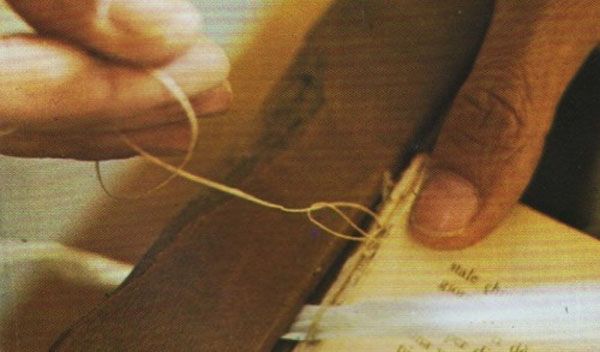
RUSTIC SEWN.
The book bound by this system is much less resistant than the one that has been by the previous one.
There is another method of sewing, called , which does not require a loom. Two grooves are marked on the backs of the sheets (one at the head and the other at the foot) and then the threaded needle is passed with the right hand through the first groove of the head where the left hand picks it up, which takes it to the second furrow and makes it come out, where it is taken again by the right hand, which pulls the thread until they remain outside, at the end, from 2 to 3 cm.
The second sheet is then taken and done as in the previous one, but starting with the lower groove; when removing the needle the thread is tied with the end that was left loose. It continues operating like this until the end, but without making knots again until reaching the last sheet, where two chain stitches will be made with the penultimate sheet.
Source: tricksandcrafts.com


